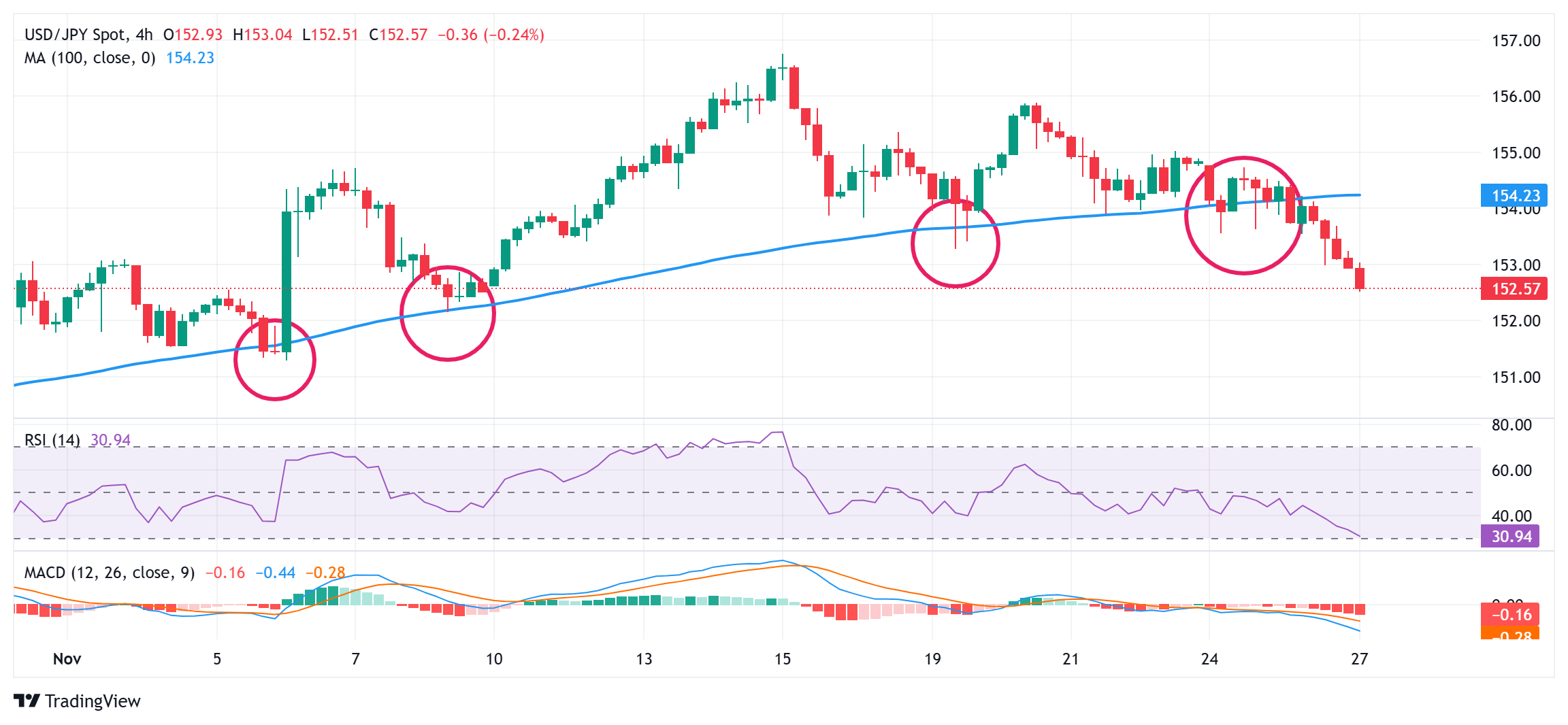- The Japanese Yen draws haven flows amid concerns over Trump’s tariff plans and geopolitical risks.
- The USD languishes near the weekly low amid sliding US bond yields and weighs on the USD/JPY pair.
- BoJ rate-hike uncertainty warrants caution for the JPY bulls ahead of the crucial US inflation data.
The Japanese Yen (JPY) buying remains uninterrupted on Wednesday, which, along with a modest US Dollar (USD) weakness, drags the USD/JPY pair below the 152.00 mark, or a three-week low during the early European session. Against the backdrop of geopolitical risks stemming from the protracted Russia-Ukraine war, concerns about US President-elect Donald Trump's tariff plans turn out to be key factors driving flows towards the safe-haven JPY.
Furthermore, expectations that Trump's US Treasury Secretary nominee, Scott Bessent will restrain budget deficits continue to drag the US Treasury bond yields lower. This, in turn, keeps the USD bulls on the defensive near the weekly low and offers additional support to the lower-yielding JPY. That said, the uncertainty over the Bank of Japan's (BoJ) rate-hike plans could act as a headwind for the JPY ahead of Wednesday's important US macro releases.
Japanese Yen bulls retain near-term control amid flight to safety, sliding US bond yields
- Concerns that US President-elect Donald Trump's tariffs would trigger trade wars, and impact the global economy, continue to drive some haven flows towards the Japanese Yen.
- Scott Bessent's nomination as the US Treasury secretary provided some respite to US bond investors and dragged the benchmark 10-year US Treasury yield to a two-week low on Monday.
- Data released on Tuesday showed broadening service-sector inflation in Japan, keeping the door open for another rate hike by the Bank of Japan at its next policy meeting in December.
- Japanese Prime Minister Shigeru Ishiba said on Tuesday that he would ask companies to implement significant wage hikes at the annual "Shuntō" negotiations next spring.
- The November FOMC meeting minutes revealed that the Committee could pause its easing of the policy rate and hold it at a restrictive level if inflation remained elevated.
- Officials expressed confidence that inflation is easing and the labor market is strong, which should allow the Federal Reserve to cut rates further, albeit at a gradual pace.
- According to the CME Group's FedWatch Tool, traders are currently pricing in a 63% chance that the Fed will lower borrowing costs by 25 basis points in December.
- The US Dollar struggles to gain any meaningful traction and languishes near the weekly low touched on Tuesday, exerting additional pressure on the USD/JPY pair.
- Lebanon-based Hezbollah militant group said that it launched drones towards Israel on Tuesday night, while Israel launched air strikes on Beirut's southern suburbs.
- Moments later, US President Joe Biden announced that Lebanon and Israel have agreed to the ceasefire deal, which comes into effect from 02:00 GMT this Wednesday.
- Traders now look forward to the first revision of the US Q3 GDP print and the US Personal Consumption Expenditure (PCE) Price Index for some meaningful impetus.
- The market attention will then shift to a slew of Japanese macro data, including Tokyo's Core CPI report, due for release during the Asian session on Friday.
USD/JPY acceptance below the 152.00 pivotal support sets the stage for deeper losses
From a technical perspective, the overnight close below the 100-period Simple Moving Average (SMA) on the 4-hour chart and the subsequent downfall favors bearish traders. Moreover, oscillators on the daily chart have just started gaining negative traction and support prospects for a further USD/JPY depreciating move. Hence, some follow-through weakness towards the very important 200-day SMA, currently pegged around the 152.00 mark, looks like a distinct possibility. A convincing break below the latter could expose the monthly swing low, around the 151.30-151.25 region.
On the flip side, the 153.00 round figure might now act as an immediate hurdle ahead of the 153.25-153.30 region. A sustained strength beyond the latter might trigger a short-covering rally and allow the USD/JPY pair to reclaim the 154.00 mark. The upward trajectory could extend further towards the 154.60 intermediate hurdle en route to the 155.00 psychological mark and the next relevant hurdle near the 155.35-155.40 area.
Economic Indicator
Gross Domestic Product Annualized
The real Gross Domestic Product (GDP) Annualized, released quarterly by the US Bureau of Economic Analysis, measures the value of the final goods and services produced in the United States in a given period of time. Changes in GDP are the most popular indicator of the nation’s overall economic health. The data is expressed at an annualized rate, which means that the rate has been adjusted to reflect the amount GDP would have changed over a year’s time, had it continued to grow at that specific rate. Generally speaking, a high reading is seen as bullish for the US Dollar (USD), while a low reading is seen as bearish.
Read more.Next release: Wed Nov 27, 2024 13:30 (Prel)
Frequency: Quarterly
Consensus: 2.8%
Previous: 2.8%
Source: US Bureau of Economic Analysis
The US Bureau of Economic Analysis (BEA) releases the Gross Domestic Product (GDP) growth on an annualized basis for each quarter. After publishing the first estimate, the BEA revises the data two more times, with the third release representing the final reading. Usually, the first estimate is the main market mover and a positive surprise is seen as a USD-positive development while a disappointing print is likely to weigh on the greenback. Market participants usually dismiss the second and third releases as they are generally not significant enough to meaningfully alter the growth picture.
Information on these pages contains forward-looking statements that involve risks and uncertainties. Markets and instruments profiled on this page are for informational purposes only and should not in any way come across as a recommendation to buy or sell in these assets. You should do your own thorough research before making any investment decisions. FXStreet does not in any way guarantee that this information is free from mistakes, errors, or material misstatements. It also does not guarantee that this information is of a timely nature. Investing in Open Markets involves a great deal of risk, including the loss of all or a portion of your investment, as well as emotional distress. All risks, losses and costs associated with investing, including total loss of principal, are your responsibility. The views and opinions expressed in this article are those of the authors and do not necessarily reflect the official policy or position of FXStreet nor its advertisers. The author will not be held responsible for information that is found at the end of links posted on this page.
If not otherwise explicitly mentioned in the body of the article, at the time of writing, the author has no position in any stock mentioned in this article and no business relationship with any company mentioned. The author has not received compensation for writing this article, other than from FXStreet.
FXStreet and the author do not provide personalized recommendations. The author makes no representations as to the accuracy, completeness, or suitability of this information. FXStreet and the author will not be liable for any errors, omissions or any losses, injuries or damages arising from this information and its display or use. Errors and omissions excepted.
The author and FXStreet are not registered investment advisors and nothing in this article is intended to be investment advice.
Recommended content
Editors’ Picks

AUD/USD advances beyond 0.6400 after stellar Aussie jobs data
AUD/USD gained strong positive traction on Thursday following the release of upbeat Australian jobs data, which pointed to a still resilient labour market and forced investors to scale back their bets for a rate cut by the RBA in February.

USD/JPY retreats from two-week top; BoJ uncertainty could limit losses
USD/JPY drifts lower on Thursday and snaps a three-day winning streak to a two-week high touched the previous day. The downside, however, seems limited amid diminishing odds for another BoJ rate hike next week, which, along with the risk-on mood, could undermine the safe-haven JPY.

Gold price retains its bullish bias near two-week high on Fed rate cut optimism
Gold price stands firm near the $2,720-2,722 area, or over a two-week high on Thursday amid the likelihood of a Fed rate cut next week. Furthermore, geopolitical risks and trade war fears remain supportive of the bullish sentiment surrounding the safe-haven XAU/USD.

Ripple's XRP eyes massive rally after posting bullish flag, high profit-taking poses threat
Ripple's XRP continued its rally on Wednesday as it looks to test the upper boundary of a key flag channel. Following the recent price rise, investors booked profits worth nearly $800 million while options traders bet on the remittance-based token hitting the $5 mark.

BTC faces setback from Microsoft’s rejection
Bitcoin price hovers around $98,400 on Wednesday after declining 4.47% since Monday. Microsoft shareholders rejected the proposal to add Bitcoin to the company’s balance sheet on Tuesday.

Best Forex Brokers with Low Spreads
VERIFIED Low spreads are crucial for reducing trading costs. Explore top Forex brokers offering competitive spreads and high leverage. Compare options for EUR/USD, GBP/USD, USD/JPY, and Gold.
